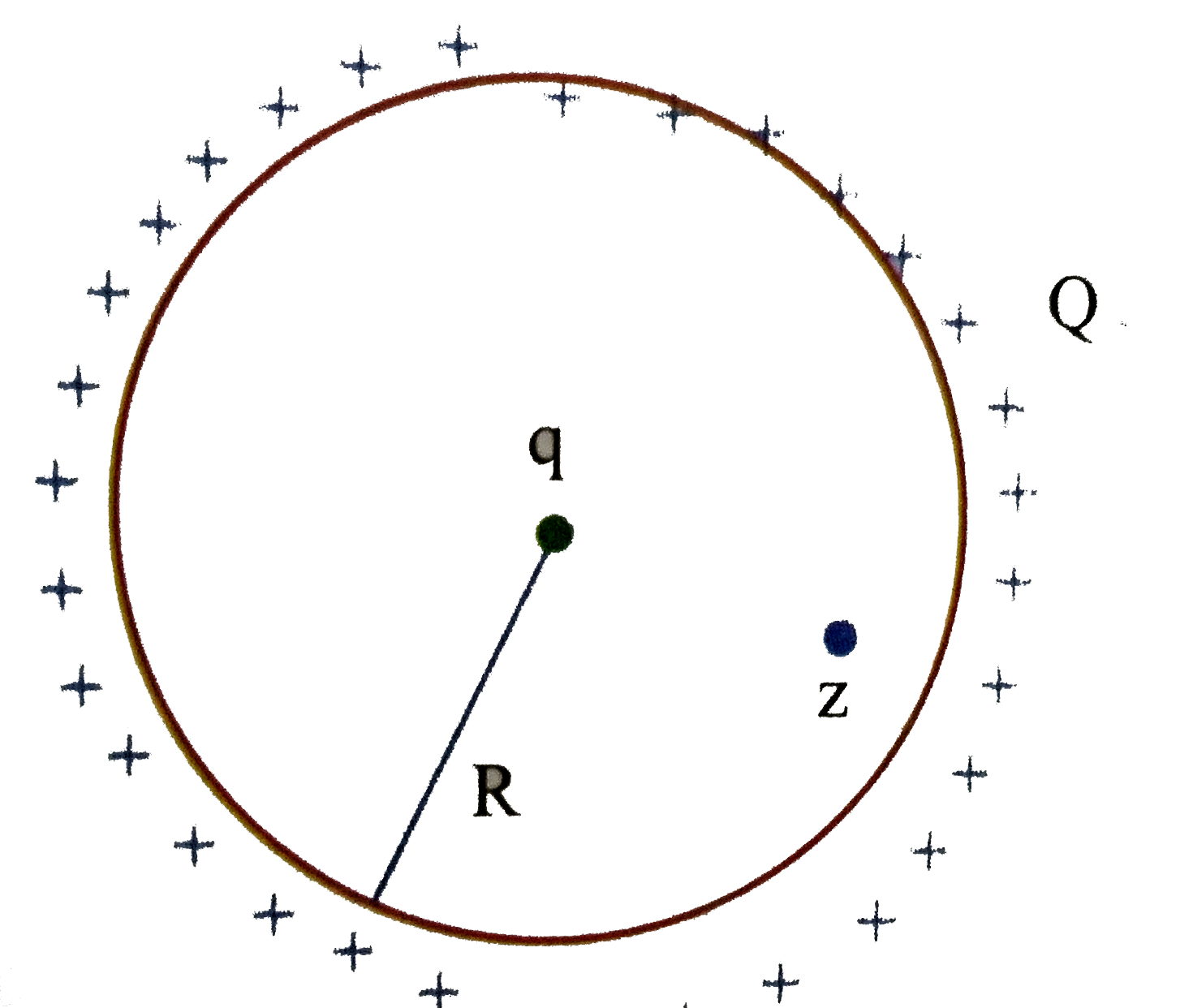STATEMENT 1: When a negative charge -q is released at a distance R from the centre and along the axis of a uniformly and positvely charged fixed ring of radius R, the negative charge does oscillation but not SHM. STATEMENT 2: The force on negative charge is always towards the centre of the ring but it is not proportional to the displacement from the centre of the ring.
Statement-1 is true, Statement-2: is true, Statement-2 is a correct explanation for Statement-1.
Statement-1 is true, Statement-2: is true, Statement-2 is NOT a correct explanation for Statement-1.
Statement-1 is true but statement-2 is false
Statement-1 is false, Statement-2 is true
The correct Answer is:A
To solve the given problem, we need to analyze the two statements provided regarding the behavior of a negative charge released near a uniformly positively charged ring.
1. Understanding the Setup:
- We have a uniformly positively charged ring with radius R.
- A negative charge −q is placed at a distance R along the axis of the ring from its center.
2. Force on the Negative Charge:
- The force acting on the negative charge due to the positive charge on the ring can be calculated using Coulomb's law.
- The force F on the charge −q at distance R from the center of the ring is given by:
F=k⋅Q⋅(−q)R2
- Here, k is Coulomb's constant, and Q is the total charge of the ring.
3. Direction of the Force:
- The force is attractive, meaning it acts towards the center of the ring. Thus, the negative charge experiences a force directed towards the center.
4. Oscillation of the Charge:
- When the charge −q is released, it will move towards the center of the ring due to the attractive force.
- Upon reaching the center, it will continue moving due to inertia and will cross the center, moving to a distance R on the opposite side.
- The charge will then be pulled back towards the center again, leading to oscillatory motion.
5. Nature of the Oscillation:
- The oscillation is not simple harmonic motion (SHM) because, in SHM, the restoring force must be directly proportional to the displacement from the equilibrium position.
- In this case, the force is not proportional to the displacement from the center of the ring; instead, it varies with the square of the distance.
6. Conclusion on Statements:
- Statement 1: True - The negative charge does oscillate but not in SHM.
- Statement 2: True - The force is directed towards the center but is not proportional to the displacement.
Final Answer:
Both statements are true, and statement 2 correctly explains statement 1.
- We have a uniformly positively charged ring with radius R.
- A negative charge −q is placed at a distance R along the axis of the ring from its center.
- The force acting on the negative charge due to the positive charge on the ring can be calculated using Coulomb's law.
- The force F on the charge −q at distance R from the center of the ring is given by:
F=k⋅Q⋅(−q)R2
- Here, k is Coulomb's constant, and Q is the total charge of the ring.
- The force is attractive, meaning it acts towards the center of the ring. Thus, the negative charge experiences a force directed towards the center.
- When the charge −q is released, it will move towards the center of the ring due to the attractive force.
- Upon reaching the center, it will continue moving due to inertia and will cross the center, moving to a distance R on the opposite side.
- The charge will then be pulled back towards the center again, leading to oscillatory motion.
- The oscillation is not simple harmonic motion (SHM) because, in SHM, the restoring force must be directly proportional to the displacement from the equilibrium position.
- In this case, the force is not proportional to the displacement from the center of the ring; instead, it varies with the square of the distance.
- Statement 1: True - The negative charge does oscillate but not in SHM.
- Statement 2: True - The force is directed towards the center but is not proportional to the displacement.
Both statements are true, and statement 2 correctly explains statement 1.
Topper's Solved these Questions
Similar Questions
Calculate potential on the axis of a ring due to charge Q uniformly distributed along the ring of radius R.
View SolutionFind the electric field at the centre of a uniformly charged semicircular ring of radius R. Linear charge density is λ
View SolutionThe maximum electric field intensity on the axis of a uniformly charged ring of charge q and radius R will be
View SolutionPotential at a point x-distance from the centre inside the conducting sphere of radius R and charged with charge Q is
View SolutionA charge +Q is uniformly distributed over a thin ring with radius R. A negative point charge −Q and mass m starts from rest at a point far away from the centre of the ring and moves towards the centre. Find the velocity of this particle at the moment it passes through the centre of the ring .
View SolutionA positive charge Q is uniformly distributed along a circular ring of radius R.a small test charge q is placed at the centre of the ring.
 View Solution
View SolutionA short electric dipole is placed at a distance x from centre O on the axis of a ring of radius R and charge Q is uniformly distributed over tis.

The net force acting on the dipole will beView SolutionA positive charge Q is uniformly distributed along a circular ring of radius R.a small test charge q is placed at the centre of the ring .The
 View Solution
View SolutionA ring of radius R has charge −Q distributed uniformly over it. Calculate the charge that should be placed at the center of the ring such that the electric field becomes zero at apoint on the axis of the ring at distant R from the center of the ring.
View SolutionA conducting ring of radius r having charge q is rotating with angular velocity ω about its axes. Find the magnetic field at the centre of the ring.
 View Solution
View Solution

